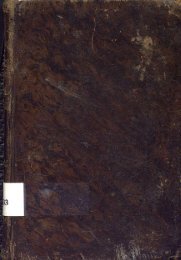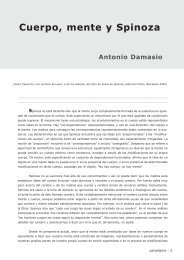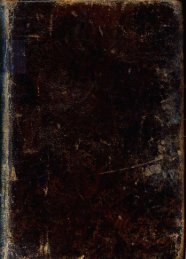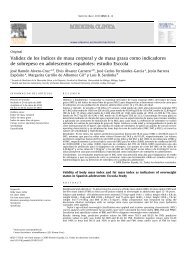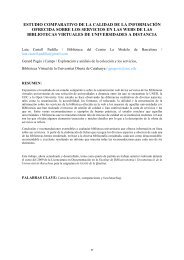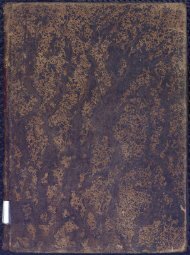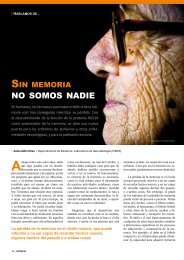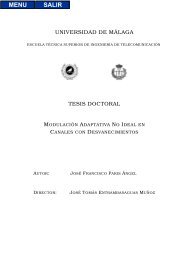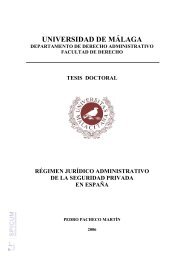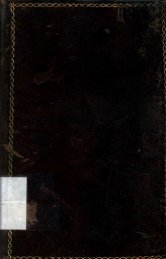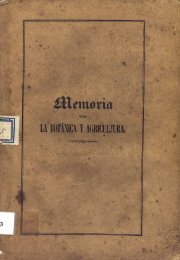Papel de las actividades superóxido dismutasa y catalasa en la ...
Papel de las actividades superóxido dismutasa y catalasa en la ...
Papel de las actividades superóxido dismutasa y catalasa en la ...
Create successful ePaper yourself
Turn your PDF publications into a flip-book with our unique Google optimized e-Paper software.
Feeding assays were carried out with soles of 80 g mean body weight, which<br />
were randomly separated into six experim<strong>en</strong>tal groups, and stocked in six 250 l tanks<br />
(20 fish per tank) with simi<strong>la</strong>r culture conditions to those <strong>de</strong>scribed above.<br />
The diet assayed was prepared in the <strong>la</strong>boratory from the commercial pellet diet<br />
routinely used in fish farms (Skreeting, Trouw España, Nutreco, Burgos, Spain).<br />
Briefly, the commercial pellet diet was crushed and mixed with tap water before adding<br />
the lyophilized alga Porphyridium cru<strong>en</strong>tum at the <strong>de</strong>sired conc<strong>en</strong>tration (10 g kg -1 ), and<br />
th<strong>en</strong> ma<strong>de</strong> into pellets again. The re-ma<strong>de</strong> pellets were allowed to dry and stored at 4 ºC<br />
until use.<br />
The commercial pellet Sanostim (Skreeting, Trouw España, Nutreco, Burgos,<br />
Spain), containing β-glucans, was used to test the response of sole phagocytes. Two<br />
groups of fish received daily one of the differ<strong>en</strong>t diets assayed: diet consisting of nonsupplem<strong>en</strong>ted<br />
commercial diet (control group); diet composed of the commercial diet<br />
containing immunostimu<strong>la</strong>nt Sanostim; and finally, a commercial diet supplem<strong>en</strong>ted<br />
with lyophilized alga (1%). Fish were fed at a rate of 20 g dry diet kg -1 biomass (2 %)<br />
per day for 4 weeks. The biomass of the fish in each aquarium was measured before the<br />
experim<strong>en</strong>t and daily ration, being adjusted accordingly. No mortality was observed<br />
during the experim<strong>en</strong>t.<br />
2.5. Immunization assay<br />
Two weeks after beginning the feeding trial, fish from one tank per treatm<strong>en</strong>t<br />
were intraperitoneally inocu<strong>la</strong>ted with a bacterin of P. damse<strong>la</strong>e subsp. piscicida. The<br />
formalin-killed aqueous vaccine was prepared with a virul<strong>en</strong>t strain of P. damse<strong>la</strong>e<br />
subsp. piscicida (Lg h411/01 ) iso<strong>la</strong>ted from diseased sole [16] according to the following<br />
protocol. Briefly, bacteria were cultured on TSAs for 24 h and one colony was<br />
inocu<strong>la</strong>ted in tubes containing 5 ml of TSBs. After 18 h incubation at 22 ºC, an aliquot<br />
of the culture, 50 μl, was inocu<strong>la</strong>ted in f<strong><strong>la</strong>s</strong>ks with 50 ml TSBs and incubated at 22ºC<br />
with continuous shaking. After 18 h incubation the culture achieved O.D. 600 of 1.2.<br />
The total bacterial number was counted, obtaining a bacterial conc<strong>en</strong>tration of 6 x 10 8<br />
bacteria ml -1 . Th<strong>en</strong> bacterial cells were killed by addition of formal<strong>de</strong>hy<strong>de</strong> to achieve<br />
1% final conc<strong>en</strong>tration, and overnight incubation. Sterility tests were performed by<br />
6



